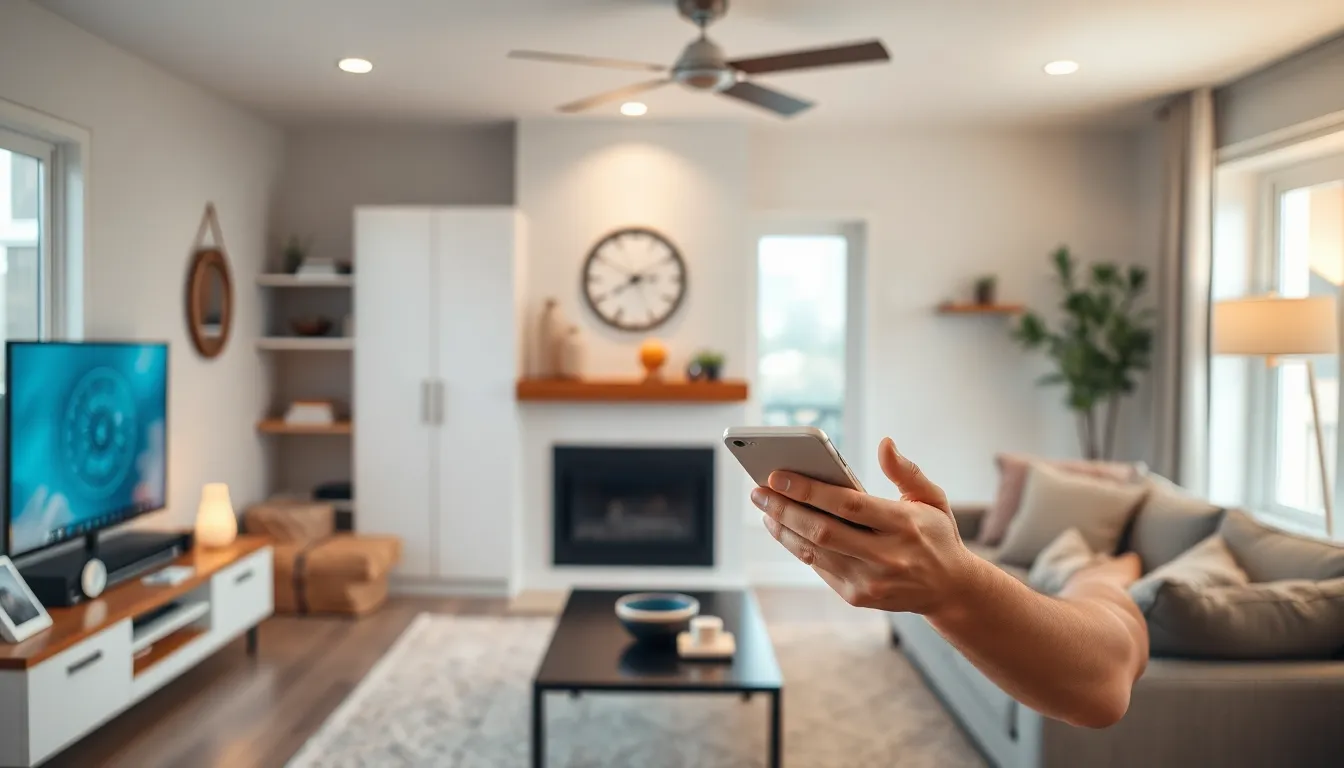In a world where your fridge could remind you to buy milk and your thermostat knows when you’re feeling chilly, the Internet of Things (IoT) is revolutionizing everyday life. But what makes these smart devices truly user-friendly? Enter the IoT user interface—a magical realm where technology meets human intuition.
Imagine a world where you don’t have to wrestle with confusing buttons or decipher cryptic error messages. With a well-designed IoT interface, users can seamlessly interact with their devices, making life not just easier but a whole lot more fun. Whether it’s adjusting your smart lights or syncing your coffee maker to your morning routine, a great user interface can turn tech into a trusty sidekick instead of a frustrating foe. Let’s dive into the fascinating world of IoT user interfaces and discover how they’re shaping the future of smart living.
Table of Contents
ToggleOverview of IoT User Interface
IoT user interfaces represent a crucial element in the overall user experience of connected devices. These interfaces facilitate seamless interaction between users and the array of smart technologies prevalent in everyday life. A well-designed interface enhances functionality, making tasks such as temperature control, security monitoring, and home automation intuitive.
Smartphone apps, voice commands, and augmented reality tools function as common examples of IoT user interfaces, allowing users to manage devices effortlessly. These interfaces prioritize user-friendliness, focusing on accessibility and simplicity. Data visualization plays an important role as well, enabling users to gauge their energy consumption or health metrics at a glance.
Design principles influence the development of IoT user interfaces. Responsive design supports various screen sizes, enhancing accessibility across devices. By implementing user feedback, developers continuously refine interfaces, ensuring they meet the needs of diverse user groups.
Security also remains a significant focus. Users must feel confident that their information is secure while interacting with connected devices. Thus, robust security features are integral to trusted IoT user interfaces.
As technology advances, the evolution of IoT user interfaces fosters enhanced communication between devices and users. This ongoing development prioritizes making smart living more integrated and responsive. Ultimately, effective IoT user interfaces transform the user experience, turning complex technology into accessible solutions that simplify daily life.
Importance of User Interfaces in IoT

User interfaces play a vital role in the Internet of Things landscape, primarily influencing user engagement and satisfaction. Effective and intuitive interfaces ensure users can navigate smart technologies effortlessly.
Enhancing User Experience
Intuitive interfaces greatly enhance user experience by making interactions seamless. Users connect with smart devices through smartphone applications, voice activation, and augmented reality tools. Each of these mediums needs to prioritize usability, ensuring users feel in control and confident. Smart design principles, including responsiveness and accessibility, foster a positive interaction environment. Users should easily accomplish tasks such as adjusting thermostats or monitoring security with minimal effort. By prioritizing user feedback during design iterations, developers create interfaces that adapt to real-world usage and preferences.
Improving Device Interaction
Device interaction improves when interfaces are designed with clarity and ease of use in mind. A central countdown may enhance Bluetooth speaker connectivity, ensuring quick and efficient pairing. Users benefit from visual cues and feedback during interactions, promoting understanding and reducing frustration. In smart home contexts, users manage appliances through streamlined controls that allow for fluid communication with multiple devices. Enhancing interactions in this manner encourages user adoption of IoT technology. As devices become smarter, intuitive user interfaces must evolve to support this increasing complexity while maintaining simplicity.
Key Elements of Effective IoT User Interfaces
Effective IoT user interfaces rely on key elements that enhance interaction and overall user experience. These components ensure smooth engagement with connected devices.
Design Principles
Design principles play a crucial role in shaping effective IoT interfaces. Clear visual hierarchies guide users, while responsive layouts adapt to various screen sizes. Simplicity in design prevents overwhelming users with excessive information. Users benefit from intuitive icons that represent functions effectively. Consistent typography contributes to readability and usability. Feedback mechanisms, such as notifications, inform users of actions taken. Prioritizing accessibility ensures that diverse users can interact comfortably with smart devices. Ultimately, applying these design principles creates a seamless experience for users across different IoT applications.
Usability Features
Usability features significantly enhance the interaction between users and IoT devices. Streamlined navigation reduces the time required to complete tasks. Voice recognition systems allow hands-free operation, increasing convenience. Customization options enable users to tailor experiences according to personal preferences. Users find value in context-aware applications that predict needs and adapt accordingly. Clear visual cues ensure tasks are easily understood without confusion. In-built tutorials guide new users through processes, further improving engagement. By integrating these usability features, developers create interfaces that prioritize user satisfaction and efficiency in everyday tasks.
Challenges in Designing IoT User Interfaces
Designing IoT user interfaces poses various challenges that require careful consideration. Complexity arises when multiple devices interact within the same environment.
Complexity of Multi-Device Environments
Managing numerous connected devices creates significant challenges for developers. Users often encounter difficulty navigating interfaces when appliances and systems offer disparate controls. Each device may require a different app or interface, leading to confusion. Achieving a seamless experience demands unified design language across all platforms. Consistency reduces user frustration and enhances operational efficiency. Integrating services into a single interface simplifies control, improving accessibility for users.
Security Considerations
Security remains a top concern in IoT user interface design. Users want assurance that their personal information stays protected while interacting with connected devices. Implementing robust authentication measures builds trust and encourages adoption. Encryption methods safeguard data transmitted across networks from unauthorized access. Developers must prioritize user privacy in their design process. Clear communication regarding data usage fosters transparency and encourages user engagement. Prioritizing secure design practices helps mitigate potential security risks.
Future Trends in IoT User Interface Design
Emerging trends in IoT user interface design are reshaping the way users engage with smart devices. Innovative technologies like AI and machine learning are making interactions more personalized and adaptive.
AI and Machine Learning Integration
AI and machine learning enhance IoT user interfaces by analyzing user preferences in real time. They allow for automated adjustments based on behavioral patterns, reducing the cognitive load on users. Personalized recommendations and predictive analytics become standard as these technologies evolve. Consequently, users experience an interface that adapts to their habits, leading to a more intuitive environment. Enhanced user satisfaction results from tailored features that align closely with individual needs. Ultimately, integrating AI leads to a smarter and more responsive interaction with connected devices.
Voice and Gesture Controls
Voice and gesture controls significantly change the landscape of IoT user interfaces. Users can interact with devices hands-free, improving accessibility and convenience in daily routines. These controls cater to a broad audience, including those with mobility challenges. Enhanced natural language processing boosts the effectiveness of voice commands, making them more reliable. Gesture recognition adds another layer of interaction, allowing users to manage devices through simple movements. Combined, these technologies promote a seamless, engaging experience that aligns with modern lifestyle demands.
The evolution of IoT user interfaces is crucial for enhancing user interactions with smart devices. As technology becomes more integrated into daily life intuitive and user-friendly designs will determine how effectively individuals engage with connected systems. Prioritizing usability and security is essential for fostering trust and satisfaction among users.
Emerging trends like AI-driven personalization and advanced gesture controls are setting new standards for accessibility and ease of use. By focusing on clear communication and streamlined navigation developers can create interfaces that not only simplify tasks but also enrich the overall user experience. The future of IoT hinges on these innovative interfaces that empower users to seamlessly integrate technology into their lives.





